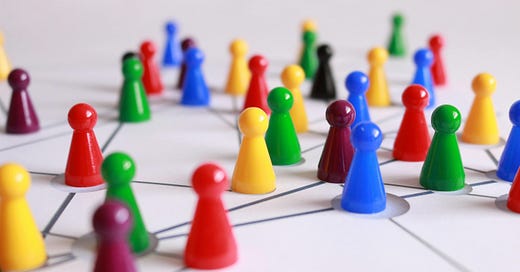🏷️ Categories: Social relationships, Memory
My memory is not only in my brain, it is also in the brains of those around me.
We tend to think of memory as a hard disk, in reality our memory is not isolated, it interconnects us with other people.
We are social beings and we interact to the point of weaving a large network of contacts through which we exchange information (Hutchins, 1995). Your memory is not only yours, it is part of a large group memory with a curious evolutionary explanation and with implications even in the relationship with your partner.
Your transactive memory says a lot about who you are.
We are all connected
Transactive memory is deeply linked to human evolution.
As humans evolved, their knowledge about the world increased until they reached the point where knowledge exceeded individual capacities of time and memory. At this point, if each person specialized in a few areas, a network of shared knowledge would eventually form (Wegner, 1991; Malone & Laubacher, 1998). The more you expand your social circle, the more knowledge you will have.
These people are places to go to consult information, they are like books.
I'll tell you a story.
In my house we make homemade roscos every Christmas using an old family recipe that comes from my great-grandmother. Every Christmas, my mother reminds me exactly the quantities of each ingredient, which in turn was just what my grandmother used to make with my mother. The recipe is not written down anywhere, but in my family we all know it.
I didn't know my great-grandmother, but I have parts of her memory.
That is also transactive memory.
Transactive memory in couples
Transactive memory talks about your communication and trust in a partner.
The more time we spend with a person, the more we know about their skills and knowledge. A couple with high transactive memory knows perfectly well in which areas their partner excels, both are used as a source of information and trust and communication in the couple is higher (Wegner, 1995).
This point in the couple is precious, you bring value and complement each other.
Leverage transactive memory
You are a valuable source of information for many, and many are for you.
According to Lewis and Herndon (2011), transactive memory is useful when tasks are group tasks and require very diverse knowledge, also when tasks need to bring theoretical knowledge into practice, since in many occasions there is a lack of practice or theoretical basis to carry out the process and we need to resort to others to exchange information.
The simple fact of knowing your teammates well greatly minimizes errors and the time we waste searching for information (Hirst & Manier, 2008). In addition, it allows you to better assign tasks and give value to what everyone knows.
Know, share and learn.
The Google effect
Why memorize if it's all on the Internet?
I always hear that phrase from teenagers when they have to memorize something.
They suffer from what I call the “Google Effect”.
The widespread use of the internet is affecting people's ability to memorize. When a person knows that information is easily accessible, their effort to internalize knowledge is much less (Sparrow et al., 2011) and therefore, they forget everything they learn sooner. Remember what I said at the beginning, the more transactive memory you share with someone, the better your communication is and the more confidence you have in each other's knowledge.

We are less interested in learning about the interests and skills of others and value their judgment less. We trust Google more than our friends.
Conversations end up becoming more superficial.
✍️ It's your turn: What do you do when you have a problem, do you always know the ideal person to solve it or do you go running to Google?
💭 Quote of the day: “Good company is the company of intelligent, well-informed people, who converse a great deal; that is what I call good company” Jane Austen in Persuasion.
PS: If you liked today's letter, I'm sure you'll love this one. In it I talk about Gibson affordances, a technique related to today's topic.
See you next time! Take care 😊.
References 📚
Hirst, W., & Manier, D. (2008). Towards a psychology of collective memory. Memory, 16(3), 183-200. https://doi.org/10.1080/09658210701811912
Hutchins, E. (1996). Cognition in the Wild. https://doi.org/10.7551/mitpress/1881.001.0001
Sparrow, B., Liu, J., & Wegner, D. M. (2011). Google Effects on Memory: Cognitive Consequences of Having Information at Our Fingertips. Science, 333(6043), 776-778. https://doi.org/10.1126/science.1207745
Wegner, D. M. (1987). Transactive Memory: A Contemporary Analysis of the Group Mind. En Springer eBooks (pp. 185-208). https://doi.org/10.1007/978-1-4612-4634-3_9
Wegner, D. M. (1991). The Illusion of Conscious Will. En The MIT Press eBooks. https://doi.org/10.7551/mitpress/3650.001.0001







